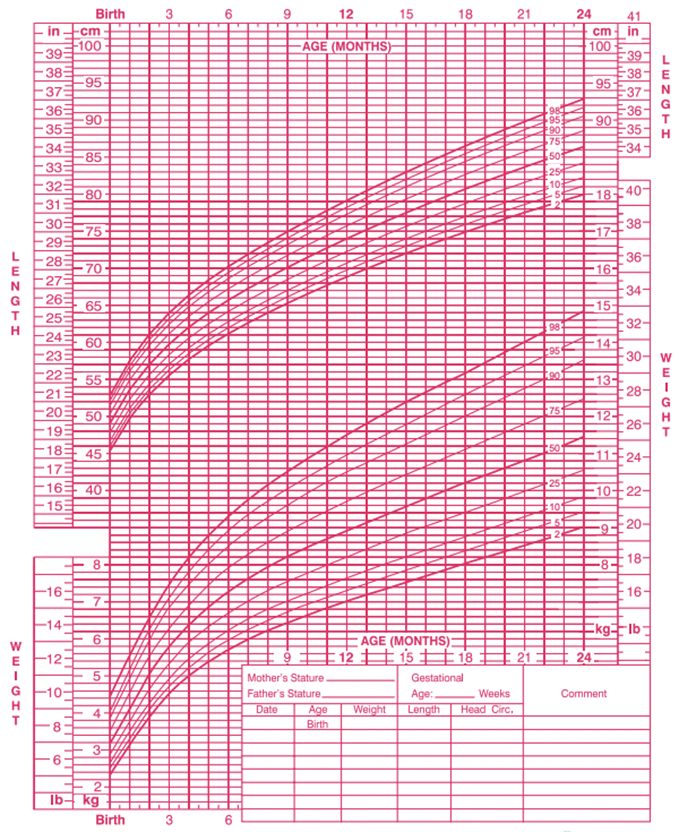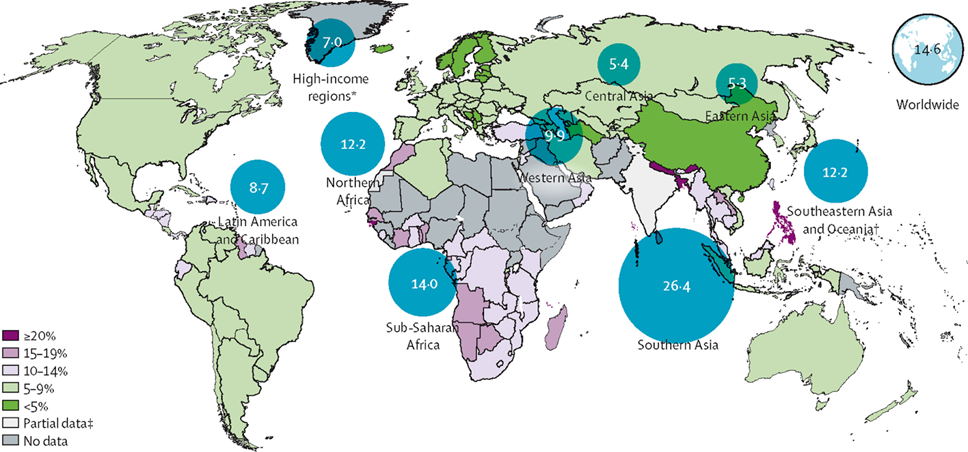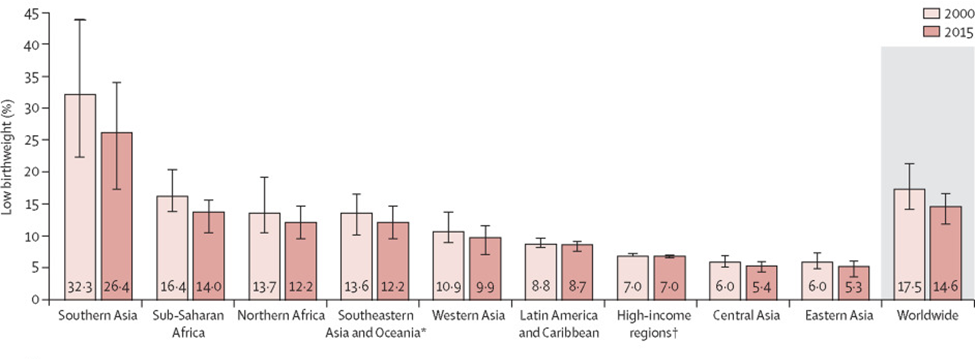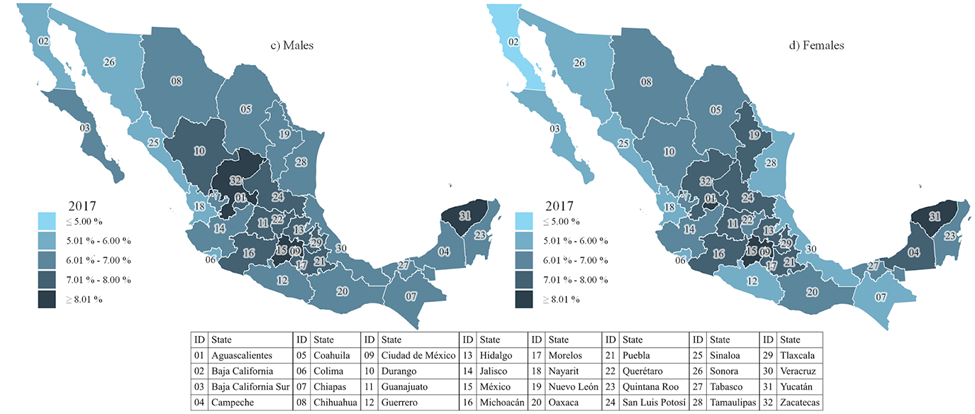2.2: Growth in Body Weight
- Page ID
- 139027
Overview of Growth in Body Weight
The average newborn weighs approximately 7.5 pounds, although a healthy birth weight for a full-term baby is considered to be between 5 pounds, 8 ounces (2,500 grams) and 8 pounds, 13 ounces (4,000 grams). For the first few days of life, infants typically lose about 5 percent of their body weight as they eliminate waste and become accustomed to feeding. This weight loss is temporary, and is followed by a rapid period of growth. By the time infants are 4 months old, their birth weight has usually doubled, and by one year their weight has tripled. By age two, their weight has quadrupled. Figure \(\PageIndex{1}\)shows this rapid growth in weight for females from birth through 24 months of age

Low Birth Weight
Birth weights vary, but a birth weight too low can negatively impact the development of the child. Low birthweight (LBW) is defined as a birthweight below 2,500 grams or 5 pounds, 8 ounces regardless of gestational age. Very low birth weight (VLBW) is less than 1,500 grams or 3 pounds, 5 ounces and extremely low birth weight (ELBW) is less than 1,000 grams or 2 pounds, 3 ounces (World Health Organization, 2004). LBW is a critical topic as the percentage of children with a LBW varies greatly between countries and between racial/ethnic groups within the same country, and is related to potential long term developmental challenges.
In the U.S. the percentage of infants born with a LBW was 8.31% for 2019, a non-significant increase from 2018 (8.28%) with Black (14.15%) and Hispanic/Latinx (7.55%) women more likely to have children with a LBW compared to white (6.89%) women (Martin et al., 2021). Globally, it is estimated that 14–20% of all births, or over 20 million newborns annually, are LBW. Figure \(\PageIndex{1}\) shows national and regional estimates of the low birth weight prevalence in 2015. The specific study this data is derived from estimated the global prevalence of LBW at 14.6% (Blencowe et al, 2019). The data from this study also finds important differences between countries. An estimated 5.4% of infants are born LBW in Eastern Asia, 14% in Sub-Saharan Africa, and up to 26% in Southern Asia. Low and middle income countries account for a disproportionate number of LBW newborns, as over 95% of the world’s LBW infants are born in low and middle income countries. Figure \(\PageIndex{2}\) shows the percentage of change in LBW from 2000 to 2015. Worldwide and across different regions, the percentage of LBW is trending downward. For example, in Southern Asia, the percentage of LBW infants in 2000 was 32.3%, but it dropped to 26.4% in 2015. [2]


Percentage of change in LBW from 2000 to 2015, worldwide and across different regions. Southern Asia: 2000 32.3%, 2015 26.4, Sub-Saharan Africa: 2000 16.4% 2015 14.0%, Northern Africa: 2000 13.7% 2015 12.2%, Southeastern Asia and Oceania: 2000 13.6% 2015 12.2%, Western Asia: 2000 10.9% 2015 9.9%, Latin America: 2000 8.8% 2015 8.7%, High-income regions: 2000 7.0% 2015 7.0%, Central Asia: 2000 6.0% 2015 5.4%, Eastern Asia: 2000 6.0% 2015 5.3%, Worldwide: 2000 17.5% 2015 14.6% [4]
While there is a global downward trend for infants born with a LBW, some countries have experienced an increase. Mexico is a country in the southern part of North America that is made up of 32 states. The incidence of LBW in Mexico, at the national level, increased from 6.2% in 2008 to 7.1% in 2017. As Figure \(\PageIndex{4}\) shows, at the state level, Mexico City reported the highest incidence followed by Southeastern and Central states (Mexico State, Aguascalientes and Yucatan); however, the states with the highest increase are located in the north of the country (Baja California Sur, Nuevo León, and Zacatecas). [5]

( [6])
LBW is a substantial public health challenge in every country, associated with a range of potential developmental challenges (Evensen et al., 2020; Longo et al., 2021; Van de Pol & Allegaert, 2020). More than 80% of neonatal deaths are in LBW newborns (Blencowe et al., 2012; Katz et al., 2013; Lee et al., 2013). LBW newborns also have a higher risk of stunting in childhood, and long-term developmental and physical health challenges (Blencowe et al., 2013; Christian et al., 2013). Approximately 5–10% of all VLBW infants show major motor challenges, while 25–50% have cognitive, behavioral and/or attention challenges. Additionally, LBW, especially ELBW, is associated with long-term cognitive, language, executive function and learning difficulties (Aarnoudse-Moens et al., 2009; Barre et al., 2011; Blasco et al., 2020; Grunau, Whitfield & Davis, 2002; Marchman et al., 2019; Squarza et al., 2016; Zerbeto, Cortelo & Filho, 2015). [7] [8]
LBW is a critical topic for infant and toddler caregivers to be aware of because the experiences LBW children have during the first three years can potentially reduce the severity of developmental challenges. For example, when LBW infants experience high levels of sensitive caregiving, they improve their executive function abilities faster and catch up to non-LBW peers in executive function abilities by five years of age (Camerota et al., 2015). In contrast, when LBW infants experience lower than average sensitive caregiving, they continue to show lower executive function skills throughout the first five years. Caregiver sensitivity refers to the timing of a caregiver’s response to a child and the ability to respond appropriately to the child’s needs. In addition to sensitivity, responsiveness is also an important characteristic. Responsive caregiving, or interactions in which caregivers give appropriate responses to a child’s signals, leads to stronger language abilities in LBW toddlers (Madigan et al., 2015). Language development in LBW infants is enhanced when caregivers are responsive and sensitive in their caregiving and elaborate in their communication (Loi et al., 2017; Spencer-Smith et al., 2019). [9]

[1] “Physical Growth and Development in Newborns and Toddlers” by: Tera Jones from Lumen Learning.
[2] Cutland et al., (2017). Low birth weight: Case definition & guidelines for data collection, analysis, and presentation of maternal immunization safety data. Vaccine, 35(48Part A), 6492.
[3] Image from Blencowe et al., (2019). National, regional, and worldwide estimates of low birthweight in 2015, with trends from 2000: A systematic analysis. The Lancet Global Health, 7(7), e849-e860. CC by 4.0
[4] Image from Blencowe et al., (2019). National, regional, and worldwide estimates of low birthweight in 2015, with trends from 2000: A systematic analysis. The Lancet Global Health, 7(7), e849-e860. CC by 4.0
[5] Ancira-Moreno et al., (2021). Incidence of low birth weight in Mexico: A descriptive retrospective study from 2008–2017. Plos one, 16(9), e0256518. CC by 4.0
[6] Image from Ancira-Moreno et al., (2021). Incidence of low birth weight in Mexico: A descriptive retrospective study from 2008–2017. Plos one, 16(9), e0256518. CC by 4.0
[7] Blencowe et al., (2019). National, regional, and worldwide estimates of low birthweight in 2015, with trends from 2000: A systematic analysis. The Lancet Global Health, 7(7), e849-e860. CC by 4.0
[8] Longo, et al., (2021). Neurodevelopmental outcome of preterm very low birth weight infants admitted to an Italian tertiary center over an 11-year period. Scientific Reports, 11(1), 1-10.
[9] Scherer et al., (2019). The relationship between responsive caregiving and child outcomes: evidence from direct observations of mother-child dyads in Pakistan. BMC Public Health, 19(1), 1-10. CC by 4.0

